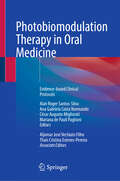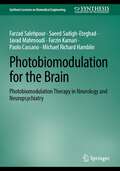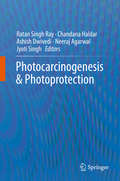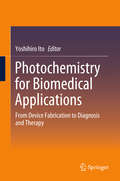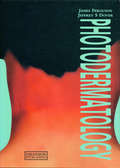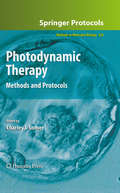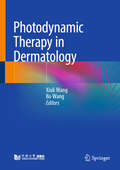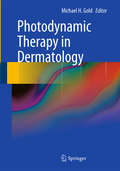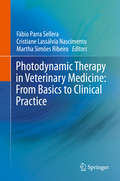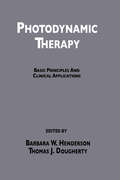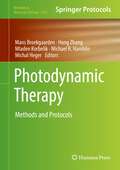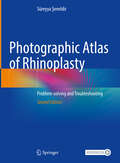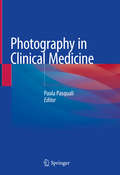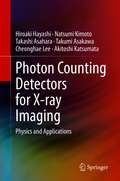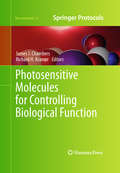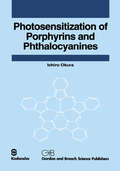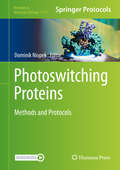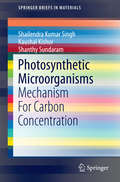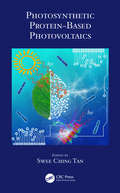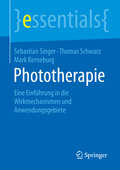- Table View
- List View
Photobiomodulation Therapy in Oral Medicine: Evidence-based Clinical Protocols
by Alan Roger Santos-Silva Ana Gabriela Costa Normando César Augusto Migliorati Mariana de Pauli PaglioniPhotobiomodulation (PBM) includes a broad range of nonionizing light sources that, when applied to tissues, lead to anti-inflammatory effects, promote wound healing and tissue repair, improve neural function, and exert an analgesic effect. Although PBM is well established and accessible technique, there is great variability in PBM parameters, protocols, and equipment, which hampers consistent application. This comprehensive book intents to assist the clinician in determining the most appropriate PBM parameters according to the light source available, in a practical and easy way. Written by experts in the PBM and Oral Medicine fields, it provides the utmost protocols for treatment and prevention of the most prevalent diseases and conditions affecting the mouth and the mandibulo-maxillary complex, in the day-to-day patient care. The protocols have been established based on published articles with high scientific evidence, mainly Systematic Reviews, Meta-analysis, and Randomized Clinical Trials. The work is divided into three main sections: Photobiomodulation, Supportive Care in Cancer, and Oral Medicine. In each part, the subtopics encompass the most prevalent and relevant diseases and conditions that may beneficiate of PBM therapy. All chapters include a brief disease definition, followed by diagnosis methods and treatment options including PBM. Each chapter presents a suggestion of PBM protocol, with reproducible parameters that may be easily performed by qualified professionals. Photobiomodulation Therapy in Oral Medicine - Evidence-based Clinical Protocols aims to assist clinical practitioners in decision-making when it comes to classical Oral Medicine, oncology support as well as bone healing and repair.
Photobiomodulation for the Brain: Photobiomodulation Therapy in Neurology and Neuropsychiatry (Synthesis Lectures on Biomedical Engineering)
by Farzad Salehpour Saeed Sadigh-Eteghad Javad Mahmoudi Farzin Kamari Paolo Cassano Michael Richard HamblinPhotobiomodulation for the Brain: Photobiomodulation Therapy in Neurology and Neuropsychiatry collects scientific evidence covering a broad range of topics, including the optimum dosimetry, treatment regimens, irradiation sites, irradiance and fluence, treatment times, and possible side effects of this neuromodulation therapy. Over the past two decades, brain photobiomodulation (PBM) therapy has been introduced as an innovative modality for stimulating neural activity to improve brain function and is predicted to become a promising strategy for neurorehabilitation in the coming years. This book introduces PBM therapy to the worldwide medical community, providing worthwhile scientific insights and promoting the acceptance of this field among neurologists, psychiatrists, neurorehabilitation practitioners, and physiotherapists, as well as neuroscience clinicians and researchers. From a physics point of view, scientists in the photonics, medical physics, and light-dosimetry fields will also benefit from the book.
Photocarcinogenesis & Photoprotection
by Jyoti Singh Ratan Singh Ray Chandana Haldar Ashish Dwivedi Neeraj AgarwalThis book highlights the problem of UV-R-induced photocarcinogenesis and its molecular mechanism. It covers different photosensitive xenobiotics (drugs, cosmetics, and environmental pollutants) and their photosensitization mechanisms under ambient UV-R exposure. It also summarizes the role of nanotechnology in skin cancer remedies. It provides a brief overview of the various novel nanocarriers for cosmeceuticals like nanoemulsions, liposomes, solid lipid nanoparticles (SLNs), dendrimers, inorganic nanoparticles, nanocrystals, etc., nanotechnology-based cosmeceutical products which are available in the market. It highlights the possible health hazards caused by nanoparticles on exposure of nano-based cosmetics and describes the recent regulatory rules applied to avoid the nanotoxicity.
Photochemistry for Biomedical Applications: From Device Fabrication to Diagnosis and Therapy
by Yoshihiro ItoThis book describes medical applications of photochemistry. In the first part, a general introduction to photochemistry and related phototechnologies is provided. In the second part, photochemistry-based medical applications for diagnostics (biochips and bioimaging) and therapeutics (biomaterials for artificial organs, medical adhesives, dental materials, drug-delivery systems, tissue engineering, and photodynamic therapy) are described, with examples of recent research. The year 2015 is the International Year of Light and Light-Based Technologies. Light plays a vital role in our daily lives and is important in many interdisciplinary scientific fields in the twenty-first century. Light-based concepts have revolutionized medicine, including areas such as oncology, molecular biology, and surgery. Although photochemistry has contributed significantly to medicine directly and through photochemical fabrication of biomaterials, a book giving a comprehensive overview of recent progress has not been published until now. The aim of this book is to highlight the contributions of photochemistry in interdisciplinary fields of chemistry and medical engineering. This book will be useful for chemists who are interested in medical applications of photochemistry and engineers who are eager to learn the principles of photochemistry to enable its use in practical applications.
Photodermatology
by James Ferguson Jeffrey DoverThe study of the biological effects of ultraviolet and visible light on the skin has expanded rapidly over the last 20 years, recognizing the clinical significance of light sensitive skin disorders. This book addresses all aspects of photodermatology by providing a clear straightforward introduction to these diseases, their investigation, diagnosis and management, including the use of lasers. Each light sensitive disorder and each type of phototherapy is supported by the principles of the underlying photophysics, chemistry and biology. Doctors, nurses and technicians all have an important role to play in the diagnosis of photodermatoses and in the administration of phototherapy. This concise, richly illustrated text provides them with valuable insights and a good working overview of the light related areas of dermatology.
Photodermatology (Basic And Clinical Dermatology Ser. #38)
by Henry W. Lim Herbert Honigsmann John L. M. HawkCovering the entire array of photodermatological topics necessary to stand at the head of thisburgeoning discipline, this source contains expertly written chapters that offer recommendationsand guidelines from opinion-forming international authorities. Reviewing the entire range ofphotodermatoses, as well as the management, treatment, i
Photodynamic Therapy
by Charles J. GomerBiological interactions of visible light with photosensitizers have been studied for over a century while controlled clinical applications of light and photosensitizers to treat solid tumors, known as photodynamic therapy, have been evolving since the mid 1970's. In Photodynamic Therapy: Methods and Protocols, leading PDT scientists and clinicians provide the first comprehensive collection of methods and protocols specifically related to relevant mechanistic, dosimetric, preclinical, and clinical procedures used in current PDT research. Reflecting the growing number of studies demonstrating that immunological, tumor microenvironmental, and vascular responses are all contributing to PDT treatment outcomes, the contents of this volume move beyond the more traditional PDT concepts in order to investigate the numerous signal transduction and cell death pathways involved. Written in the highly successful Methods in Molecular BiologyTM series format, chapters include introductions to their respective topics, lists of the necessary materials and reagents, step-by-step, readily reproducible laboratory protocols, and notes which highlight tips on troubleshooting and avoiding known pitfalls. Authoritative and cutting-edge, Photodynamic Therapy: Methods and Protocols is an ideal guide for new investigators just starting out in PDT research as well as seasoned investigators changing the direction of their research with the intention of exploring this vital field of study.
Photodynamic Therapy
by Mahmoud H. Abdel-KaderPhotodynamic Therapy: From Theory to Application brings attention to an exceptional treatment strategy, which until now has not achieved the recognition and breadth of applications it deserves. The authors, all experts and pioneers in their field, discuss the history and basic principles of PDT, as well as the fundamentals of the theory, methods, and instrumentation of clinical diagnosis and treatment of cancer. Non-oncological applications such as the use of PDT in control of parasites and noxious insects are also discussed. This book serves as a standard reference for researchers and students at all levels, clinical specialists interested in the topic and those in industry exploring new areas for development. A comprehensive exposition of both the theory and application of PDT, this book fills the gaps in the current literature by bringing together both basic understanding of the process of PDT and an expanded vision of its applications.
Photodynamic Therapy in Dermatology
by Bo Wang Xiuli WangThis book provides an overview of the contemporary landscape of photodynamic therapy in dermatology. It encapsulates the latest research accomplishments and anticipates the trajectory of its evolution for treating cutaneous ailments. Details of photodynamic therapy in clinical treatment of non-melanoma skin cancer, cutaneous melanoma, infectious dermatoses, and other cutaneous diseases are presented in the book. Dermatologists actively involved in photodynamic clinical practice will find this book immensely instructive, while novices in the field will be equally captivated and motivated by its insights.
Photodynamic Therapy in Dermatology
by Michael H. GoldPhotodynamic therapy is a proven effective treatment of actinically damaged skin cells, nonmelanoma skin cancers, and acne and other pilosebaceous conditions. As an agent for general facial rejuvenatin it has untapped potential. The current state of PDT therapy and future applications are discussed in detail in this exciting new volume. Throughout, the focus is on evidence-based clinical uses of PDT, including pretreatment regimens, avoidance and management of complications, and posttreatment suggestions.
Photodynamic Therapy in Veterinary Medicine: From Basics to Clinical Practice
by Fábio Parra Sellera Cristiane Lassálvia Nascimento Martha Simões RibeiroPhotodynamic Therapy in Veterinary Medicine: From Basics to Clinical Practice is pioneer in introducing this new therapeutic modality, a promising platform for veterinarians to treat intricate diseases like cancer and microbial infections. The book addresses from basics to clinical practice presenting the history and fundamentals of photodynamic therapy for non-experts besides encompassing a collection of basic and clinical studies in cancer and infectious diseases. Illustrations are provided to give the reader examples of successful procedures in treating pets or other animals. Future perspectives and innovative applications involving nanotechnology and advanced drug delivery are also presented. In this journey, the readers will be able to understand how the therapy works and to learn how to apply it in daily practice effectively.
Photodynamic Therapy: Basic Principles and Clinical Applications
by Barbara W. HendersonCovering all aspects of photodynamic therapy, 70 expert contributors from the fields of photochemistry, photobiology, photophysics, pharmacology, oncology and surgery, provide multidisciplinary discussions on photodynamic therapy - a rapidly-developing approach to the treatment of solid tumours.;Photodynamic Therapy: Basic Principles and Clinical Applications describes the molecular and cellular effects of photodynamic treatment; elucidates the complex events leading to photodynamics tissue destruction, particularly vascular and inflammatory responses; discusses the principles of light penetration through tissues and optical dosimetry; examines photosensitizer pharmacology and delivery systems; reviews in detail photosensitizer structure-activity relationships; illustrates novel devices that aid light dosimetry and fluorescence detection; and extensively delineates clinical applications, including early diagnosis and treatment.;A comprehensive and up-to-date reference, this book should be useful for oncologists, pharmacologists, surgeons, photobiologists, optical engineers, laser technicians, biologists, physicists, chemists and biochemists involved in cancer research, as well as graduate-level students in these disciplines.
Photodynamic Therapy: Methods and Protocols (Methods in Molecular Biology #2451)
by Hong Zhang Michael R. Hamblin Mans Broekgaarden Mladen Korbelik Michal HegerThis collection explores state-of-the-art methods and protocols for research on photodynamic therapy (PDT) and its use in a wide range of medical applications, from antiviral to anticancer. Beginning with an extensive section on in vitro and in vivo models, the volume continues with chapters on oxygen-independent photosensitizers, next-generation photosensitization strategies, contemporary insights into the immunomodulatory effects of PDT, antimicrobial effects of PDT, as well as a variety of general biochemical and molecular biological techniques. Written for the highly successful Methods in Molecular Biology series, chapters include the kind of detailed implementation advice that ensures successful results in the lab. Thorough and authoritative, Photodynamic Therapy: Methods and Protocols serves as an ideal source of inspiration for both new and established PDT scientists and a guide for designing innovative research programs in this continuously advancing and multidisciplinary field.
Photographic Atlas of Anatomy: A Photographic Atlas
by Johannes W Rohen Chihiro Yokochi Elke Lutjen-DrecollThis updated ninth edition includes revised content throughout and features additional cadaver dissection photos, medical imaging, and clinical illustrations, as well as a new appendix with learning resources that strengthen students’ understanding of the vascular, lymphatic, muscular, and nervous systems.
Photographic Atlas of Rhinoplasty: Problem-solving and Troubleshooting
by Süreyya ŞeneldirThis atlas pursues a problem-based rather than solely technique-oriented approach. Instead of focusing on open or closed rhinoplasty, it compares the relative merits of both approaches for specific anatomical problems and surgical techniques. The book incorporates a wealth of pre-, peri-, and postoperative images as well as short- and long-term results.Readers are not only introduced to ideal surgical outcomes and successful results; the author also shares his hands-on experience in revision cases. The chapters are clearly structured, and each explores a particular problem by giving an overview of the pathology and then offering possible solutions in a step-by-step approach. Individual chapters describe conditions of the radix, the dorsum, and the nasal tip and address technical questions like the indications for osteotomy and dorsum preservation. All these topics are accompanied by HD video clips using state-of-the-art Augmented Reality technology. Plastic surgeons and ENT doctors can directly and easily see the implications for their own clinical practice. As such, this book is not only a valuable addition to surgeons' bookshelves, but also offers direct support in the operating theatre.
Photographic Atlas of Rhinoplasty: Problem-solving and Troubleshooting
by Süreyya ŞeneldirThis atlas pursues a problem-based rather than solely technique-oriented approach. Instead of focusing on open or closed rhinoplasty, it compares the relative merits of both approaches for specific anatomical problems and surgical techniques. The book incorporates a wealth of pre-, peri-, and postoperative images as well as short- and long-term results.Readers are not only introduced to ideal surgical outcomes and successful results; the author also shares his hands-on experience in revision cases. The chapters are clearly structured, and each explores a particular problem by giving an overview of the pathology and then offering possible solutions in a step-by-step approach. Individual chapters describe conditions of the radix, the dorsum, and the nasal tip and address technical questions like the indications for osteotomy and dorsum preservation. All these topics are accompanied by HD video clips using state-of-the-art Augmented Realitytechnology. Plastic surgeons and ENT doctors can directly and easily see the implications for their own clinical practice. As such, this book is not only a valuable addition to surgeons' bookshelves, but also offers direct support in the operating theatre.
Photography in Clinical Medicine
by Paola PasqualiThis book explains how medical photography is part of the workflow in many specialties: it is needed for registries, to preserve information, for follow up, second opinion and teaching, among others. The book gathers information on this field, providing valuable practical tips for those that have never used photography for medical uses as well as those who use it regularly. Covering specialities ranging from dermatology, plastic surgery, dentistry, ophthalmology and endoscopy to forensic medicine, specimen photography and veterinary medicine, it highlights standardization for each procedure and relevance to ethical, patients’ perception of medical photography, cybersecurity and legal aspects. The book also presents practical sections explaining how to organize a photographic file, coding, reimbursement, compliance, use of social media and preservation as well as in depth concepts on sharp focus on blurred vision. This volume will appeal to all clinicians and practitioners interested in acquiring a high level of technical skill in medical photography.
Photon Counting Detectors for X-ray Imaging: Physics and Applications
by Hiroaki Hayashi Natsumi Kimoto Takashi Asahara Takumi Asakawa Cheonghae Lee Akitoshi KatsumataThis book first provides readers with an introduction to the underlying physics and state-of-the-art application of photon counting detectors for X-ray imaging. The authors explain that a photon-counting imaging detector can realize quantitative analysis because the detector can derive X-ray attenuation information based on the analysis of intensity changes of individual X-ray. To realize this analysis, it is important to consider the physics of an object and detector material. In this book, the authors introduce a novel analytical procedure to create quantitative X-ray images for medical diagnosis.
Photoprotective Green Pharmacology: Challenges, Sources and Future Applications
by Shanthy Sundaram Vinod K. Kannaujiya Rajeshwar P. Sinha Md. Akhlaqur RahmanThis book illustrates the role of photoprotective and radioprotective metabolites from natural sources. Various classes of radioprotective metabolites derived from cyanobacteria, algae, fungi, bryophytes, pteridophytes, gymnosperms, and higher plants have been explained to reinforce the current knowledge in this field. In addition, the book elucidates the potential applications of these metabolites in pharmaceutics, cosmetics, and biomedical sciences that will help develop commercial products in modern anti-radiation therapeutics. Topics such as stress tolerance environmental strategies, evolutionary tendency, and biosynthetic route of radioprotective compounds for cost-effective large-scale industrial production of the metabolites are also covered in the book. This book will add to the understanding of radioprotective mechanisms and curative measures for various deleterious diseases leading to cancer development. This volume also offers the latest insights into current and upcoming issues that arise from solar and atomic radiations and their amelioration by inherent radioprotective mechanisms of green plants. This book benefits readers from academia, industry, colleges, and research students to better understand the impacts of various radiations and the development of radioprotective green compounds.
Photosensitive Molecules for Controlling Biological Function
by James J. Chambers Richard H. KramerThe development of new photochemical tools, some synthesized by chemists and some provided by nature, is rapidly changing the way neurobiological research is performed in the modern laboratory. In Photosensitive Molecules for Controlling Biological Function, expert researchers in the field examine the most cutting-edge tools currently available. Divided into three sections, this detailed compendium features techniques involving natural photosensitive proteins, caged neurotransmitters, and small molecule photoswitches that bestow light sensitivity on ion channels and receptors. Written for the Neuromethods series, this volume features the type of meticulous description and implementation advice that is crucial for getting optimal results in the lab. Authoritative and practical, Photosensitive Molecules for Controlling Biological Function provides an unbiased comparison of the various photochemical tools currently available for controlling neuronal activity in order to aid scientists in the vital goal of choosing the right tools for the right job.
Photosensitization of Porphyrins and Phthalocyanines
by Ichiro OkuraPhotosensitization of Porphyrins and Phthalocyanines covers the scentific background to porphyrins and phthalocyanines, and applications of the compounds, especially for the application for photosensitization. It also has a review of advances in research and applications in this field.
Photoswitching Proteins: Methods and Protocols (Methods in Molecular Biology #2173)
by Dominik NiopekThis volume provides cutting edge protocols for using optogenetic and opto-chemical techniques across a wide spectrum of applications. Chapters guide readers through methods in neuro-optogenetics, including methods to dissect local and long-range connectivity ex vivo, investigate G-protein coupled receptors, study astrocyte-neuron networks in vitro and in vivo, employ upconversion nanoparticles for transcranial optogenetic stimulation, and use Adeno-associated virus (AAV) for delivery of optogenetic constructs. At the same time, this book covers a range of methods for non-neuronal optogenetics, including various applications of light-oxygen-voltage domains or cryptochromes for control of nucleocytoplasmic transport, transgene expression and chromatin recruitment. The book further presents protocols for traceless light-control of gene expression with melanopsin, light-inducible cAMP production, use of light-regulated receptor tyrosine kinases (Opto-RTKs), synthesis of light-dependent biomaterials, and highlights emerging tools at the intersection of optogenetics and CRISPR. Written in the highly successful Methods in Molecular Biology series format, chapters include introductions to their respective topics, lists of the necessary materials and reagents, step-by-step, readily reproducible laboratory protocols, and tips on troubleshooting and avoiding known pitfalls. Authoritative and cutting-edge, Photoswitching Proteins: Methods and Protocols aims to provide a comprehensive list of methods and tools to investigate highly dynamic pathways and behaviors in cells and animals using optogenetics.
Photosynthetic Microorganisms
by Shailendra Kumar Singh Shanthy Sundaram Kaushal KishorThis book provides a cohesive overview of carbon concentrating mechanism (CCM) of photosynthetic microorganisms such as cyanobacteria and microalgae. This unique mechanism is by far the most spectacular physiological process in algal growth and productivity. Due to this fact, the study of CCM has captivated phycologists, algal molecular and cellular biologists, botanists, agriculturalists, crop growers, and most recently algal biofuel researchers, around the world. In the brief, the authors draw a contextual in-depth overview, on the basis of the latest findings, to develop an account of the core concepts regarding state-of-the-art of CCM. Subsequent chapters use this account to explore carbon concentrating mechanism of cyanobacteria and microalgae. They highlight the concise summaries of cutting-edge research and integrated industrial applications of photosynthetic microorganism based CO2 mitigation system, across a wide spectrum of energy and environment. The brief also presents sustainable perspectives of carbon concentrating mechanism in the context of current global energy and environmental challenges.
Photosynthetic Protein-Based Photovoltaics
by Swee Ching TanEver since the discovery of the photoelectric effect, researchers have been trying to improve the efficiency of converting sunlight into electricity through photovoltaic devices. Photosynthetic organisms provide clues for harvesting sunlight and storing the energy in chemical forms. This book offers a concise overview of the fundamental concepts of photosynthesis and the emerging photovoltaic technologies, casting light on the symbiotic relation between these spheres of science. Although there are many books about the fundamentals of photosynthesis and the various aspects of the photosynthetic processes, this is the first volume to focus on the prospects of studying the photosynthetic proteins, understanding and applying their properties to design prospective solar energy conversion devices that are sustainable and efficient. All in all, the book aims to bring together the present know-how on organic photovoltaics and dye-sensitized solar cells with that of the emerging bio-photovoltaics and the underlying physics of photosynthesis to foster a more eclectic research that would converge towards a sustainable energy technology for the future. The book mainly serves as a bridge to connect biochemists, who study photosynthetic proteins, and physicists and engineers who design and develop photovoltaic devices. Scientists, engineers and students in the fields of photosynthetic research and solar energy research can use this book as a ready reference. Key selling features: Covers both methods and bio-based materials needed to build bio-based photovoltaics Focuses on both techniques and applications Summarizes the advantages and limitations of various techniques Contributors from multiple disciplines integrate the knowledge of photosynthetic proteins and the physics/engineering of photovoltaic devices. Includes adaptive designs and techniques used in other types of solar cells to for the design of protein-based PVs
Phototherapie: Eine Einführung in die Wirkmechanismen und Anwendungsgebiete (essentials)
by Sebastian Singer Thomas Schwarz Mark BerneburgDas vorliegende Essential bietet einen fundierten Einblick in die photobiologischen Wirkmechanismen, die einer Phototherapie mit UV-A, UV-B oder PUVA zu Grunde liegen. Es stellt zudem einen Leitfaden für die Durchführung einer Phototherapie dar. Die Phototherapie ist eine seit Langem genutzte und effektive Behandlungsmodalität in der Therapie verschiedenster Dermatosen. Im Wesentlichen entfaltet sie ihre Wirkung durch drei Mechanismen. Erstens führt UV-Bestrahlung zu einer Induktion von DNS-Schäden, was zum Zelltod führen kann. Zweitens beeinflusst Phototherapie sowohl angeborene wie auch spezifische Anteile des Immunsystems und entfaltet eine immunmodulatorische Wirkung. Drittens wird der Kollagenstoffwechsel verändert.
